
Ailanthus is a genus of trees belonging to the family Simaroubaceae, in the order Sapindales. The genus is native from east Asia south to northern Australasia. One species, the Tree-of-Heaven is considered a weed in some parts of the world.

Ailanthus altissima, commonly known as tree of heaven, ghetto palm, Ailanthus, varnish tree, copal tree, stinking sumac, Chinese sumac, paradise tree, or in Chinese as chouchun, is a deciduous tree in the family Simaroubaceae. It is native to northeast and central China, and Taiwan. Unlike other members of the genus Ailanthus, it is found in temperate climates rather than the tropics.
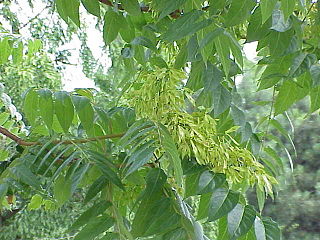
The Simaroubaceae are a small, mostly tropical, family in the order Sapindales. In recent decades, it has been subject to much taxonomic debate, with several small families being split off. A molecular phylogeny of the family was published in 2007, greatly clarifying relationships within the family. Together with chemical characteristics such as the occurrence of petroselinic acid in Picrasma, in contrast to other members of the family such as Ailanthus, this indicates the existence of a subgroup in the family with Picrasma, Holacantha, and Castela.

Ageratina altissima, also known as white snakeroot, richweed, or white sanicle, is a poisonous perennial herb in the family Asteraceae, native to eastern and central North America. An older binomial name for this species is Eupatorium rugosum, but the genus Eupatorium has undergone taxonomic revision by botanists, and some species once included in it have been moved to other genera.

Samia cynthia, the ailanthus silkmoth, is a saturniid moth, used to produce silk fabric but not as domesticated as the silkworm, Bombyx mori. The moth has very large wings of 113–125 mm (4.4–4.9 in), with a quarter-moon shaped spot on both the upper and lower wings, whitish and yellow stripes and brown background. There are eyespots on the outer forewings. The species was first described by Dru Drury in 1773.
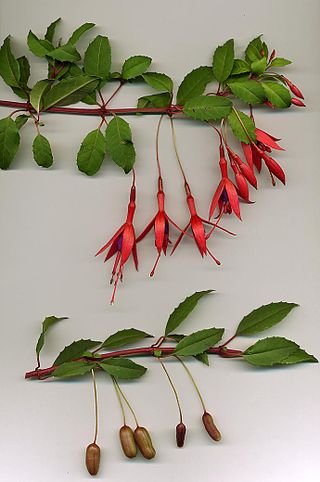
Fuchsia magellanica – commonly known as the hummingbird fuchsia, hardy fuchsia or chilco – is a species of flowering plant in the evening primrose family Onagraceae, native to the lower Southern Cone of southern South America.

Tydeidae is a family of acariform mites. As of 2016, it contained over 300 species in three subfamilies, though more species have been discovered since then.

Tydeus is a genus of mites belonging to the family Tydeidae. These are small, usually white, mites with soft bodies covered in striations and each leg terminating in two claws.

Pleospora is a genus of ascomycete fungi. This genus was originally described by Gottlob Ludwig Rabenhorst in 1857 and was revised by Wehmeyer and Müller. There was an estimated 63 species in 2008. As of 8 August 2023, the GBIF lists up to 440 species, while Species Fungorum lists about 375 species.
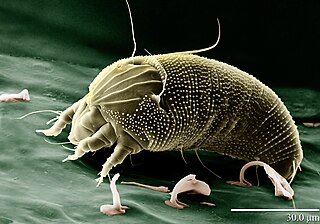
Aceria is a genus of mites belonging to the family Eriophyidae, the gall mites. These tiny animals are parasites of plants. Several species can cause blistering and galls, including erineum galls. A few are economically significant pests, while others are useful as agents of biological pest control of invasive plants such as rush skeletonweed, creeping thistle, and field bindweed.
Euseius concordis is a species of mite in the family Phytoseiidae.

Quadrastichus erythrinae Kim, 2004, is a small parasitoid wasp belonging to the family Eulophidae, but also a secondary phytophage by way of inducing galls on the leaves, stems, petioles and young shoots of various Erythrina species.
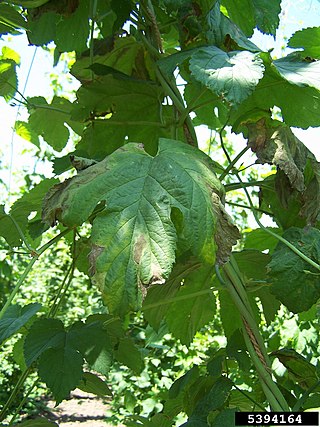
Verticillium nonalfalfae is a soilborne fungus in the order Hypocreales. It causes verticillium wilt in some plant species, particularly Ailanthus altissima. The fungus produces a resting mycelium characterized by brown-pigmented hyphae. It is most closely related to V. dahliae and V. alfalfae.

Aculops fuchsiae, commonly known as fuchsia gall mite, is a species of mite in the family Eriophyidae. It feeds on Fuchsia plants, causing distortion of growing shoots and flowers. It is regarded as a horticultural pest.
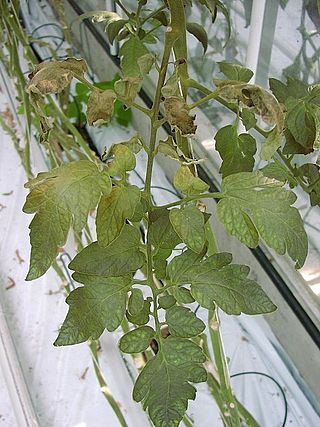
Aculops lycopersici, also known as the tomato russet mite, is a species of mite that belongs to the family Eriophyidae.

Aculops tetanothrix, also known as the willow gall mite, is a species of mite that belongs to the family Eriophydae. The mite is yellow, with brown or sometimes orange.
Aculops ailanthii, the Ailanthus leafcurl mite, is a species of eriophyid mite that infects trees-of-heaven. Very little is known about this species. A. ailanthii has been proposed as a potential biocontrol alongside ailanthus webworms and mimosa wilt in North America, where Ailanthus is a severe invasive.

Aculops rhois, the poison ivy gall mite, is a species of Eriophyid mite found in North America. They form galls in poison ivy as well as other members of North American Toxicodendron and some species of Rhus.

















